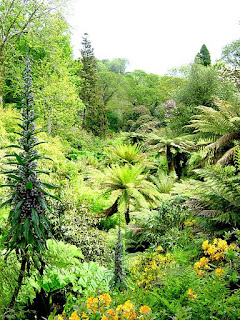The story of Heligan
The Heligan estate, five miles south of St Austell in
Cornwall, England, was acquired by the Tremayne family in the 17th
century. A succession of Tremaynes, in the 18th and 19th
centuries, developed the grounds and introduced a number of exotic plants that
could thrive in the mild climate of Cornwall, and especially the micro-climate
created by the steep-sided valley that leads away from Heligan House.
Early in the 20th century the gardens provided
full-time employment for 22 people, but then came major changes that threatened
their very existence. Sixteen of the gardeners were killed in the First World
War, and in the 1920s the owner decided to move to Italy and lease the house to
tenants. Eventually the house was sold and the gardens were allowed to grow
wild and thus be “lost”.
It was not until the early 1990s that work started to
restore the gardens, this work being done largely by volunteers. The gardens
are now a major attraction and a valuable resource in terms of their botanical
contents and as a reconstruction of a Victorian estate garden.
What you can see
The gardens are divided into two main sections, Productive
and Pleasure, which are themselves split into distinct areas.
The Productive gardens include a walled flower garden, a
melon yard and a vegetable garden. More than two hundred varieties of fruit and
vegetables are grown here.
However, most visitors come to see the Pleasure gardens
which comprise a series of individual garden scenes. There is a New Zealand garden,
an Italian garden, a crystal grotto and a sundial garden.
Perhaps the most remarkable section is the “jungle”, in which
plants from tropical parts of the world are able to grow and thrive, including
giant ferns and banana plants. The path takes visitors past four linked ponds
that provide some wonderful vistas of the largest collection of palms and tree
ferns in the United Kingdom. All that is missing is snakes and birds of
paradise!
The gardens offer many surprises, including sculptured forms
of maidens and giants that seem to grow out of the ground covered in plants.
It is not surprising that, since their discovery and
restoration, the Lost Gardens of Heligan have become the most popular private
gardens in Britain, with more than 200,000 visitors every year.
© John Welford


No comments:
Post a Comment